|

 Up
Up 
 Pilots,
Pilots,
Planes
and Pioneers

(You are here.)
 Down
Down




  Need
to Need
to
find your
bearings?
Try
these
navigation aids:
If
this is your first
visit, please stop by:
Something
to share?
Please:



|
|
Available in Française, Español, Português, Deutsch, Россию,
中文,
日本, and others.
 hile
the Wright brothers may have been the first to make a sustained,
controlled flight, they were just two among hundreds of brave men
and women who helped to give the world its wings during the earliest
days of aviation. Their Flyer was but one of many historically
important aircraft. Below are brief descriptions and photos of some of the most important
people and planes, and where available resources and links where you can find more
information. In some cases, contributors have supplied expanded
histories and biographies. Those are listed at the right and linked below. hile
the Wright brothers may have been the first to make a sustained,
controlled flight, they were just two among hundreds of brave men
and women who helped to give the world its wings during the earliest
days of aviation. Their Flyer was but one of many historically
important aircraft. Below are brief descriptions and photos of some of the most important
people and planes, and where available resources and links where you can find more
information. In some cases, contributors have supplied expanded
histories and biographies. Those are listed at the right and linked below.
A
 B
B
 C
C
 D
D
 E
E
 F
F
 G
G
 H
H
 I
I
 J
J
 K
K
 L
L
 M
M
N
 O
O
 P
P
 Q
Q
 R
R
 S
S
 T
T
 U
U
 V
V
 W
W
 X
X
 Y
Y
 Z
Z
|
|
 |
|
|
Sir George Cayley
was the scholarly baronet of Bromptom Hall (near Scarborough, England) who
first conceived of a fixed-wing aircraft in 1799, built the first
successful glider in 1804, and founded the science of aeronautics in 1810
with the publication of On Aerial Navigation, the first
scientific work in aviation. He was also the first to design
aerodynamic controls (the rudder and the elevator), the first to perform
research on the lifting properties of wing shapes, and the first to
suggest the use of an internal combustion engine to power an airplane,
although his idea of a combustible fuel was gunpowder. In
1853, near the end of his career, he designed and built a glider
(which he called a "governable parachute") that made the first recorded manned gliding flight
with his coachman aboard. Cayley's coachman, reportedly, did not
appreciate the honor. Also see:
The First Airplanes
|
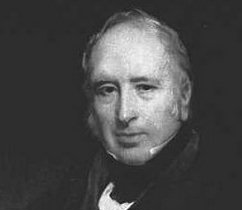
Sir George Cayley.
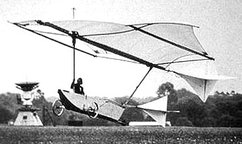
This replica of Cayley's 1853 glider flew for a documentary in 1973.
|
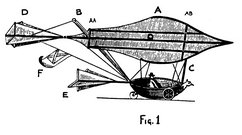
Cayley's "Governable Parachute" as it appeared in the
Mechanics Magazine in 1852.
The craft was built and flown successfully a year later.
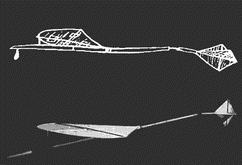
Humble beginnings -- Cayley's first glider was a kite on a stick.
Cayley's 1804 drawing (above) and a replica (below).
|
 |
Octave Chanute
was a renowned civil engineer and bridge-builder who became the nexus of
aeronautical information in the late nineteenth century. Born in France in
1832, he had emigrated to America with his parents when he was six. He
began his career in civil engineering in 1849 and built many impressive
projects, including the Union Stock Yards in Chicago and the first bridge
across the Missouri River. He semi-retired in 1890 and began to correspond
with aeronautical scientists around the world, trading scientific
information and news. He wrote a series of articles on aeronautics for the
Railroad and Engineering Journal beginning in 1891. These were
reprinted in 1894 in a book called Progress in Flying Machines, the
most comprehensive survey of aeronautics to date. In 1896, he gathered
together several young aeronautical investigators, including
Augustus
Herring, to test fly several new glider designs in the sand dunes around
Miller, IN. These experiments resulted in the Chanute-Herring biplane
glider, the most successful glider of its time and the jumping-off point
for the Wright brothers. Chanute is best remembered for a long
correspondence with Wilbur Wright that began in 1900 and documents the
invention and development of the first practical airplanes. He also
visited the Wrights at their camp in Kitty Hawk, NC.
|
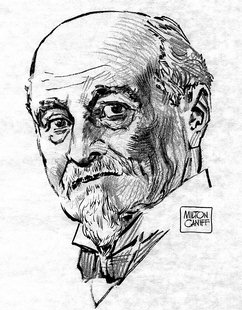
When Octave Chanute was enshrined in the Aviation Hall of Fame,
Milton Caniff drew this portrait.
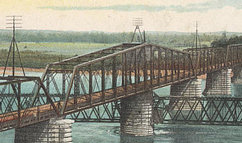
Chanute built the Hannibal Bridge in 1869. It stretched across the
Missouri River in Kansas City.
|
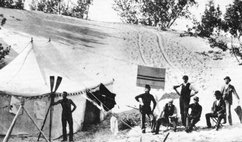
Chanute's camp at the Indiana Dunes near Miller, IN in 1896.
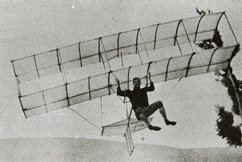
The Chanute-Herring glider incorporated a truss system similar to
what Chanute had used when building bridges.
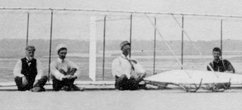
Chanute (extreme left) with the Wright brothers and the 1902 Wright
glider in Kitty Hawk.
|
 |
|
|
|

